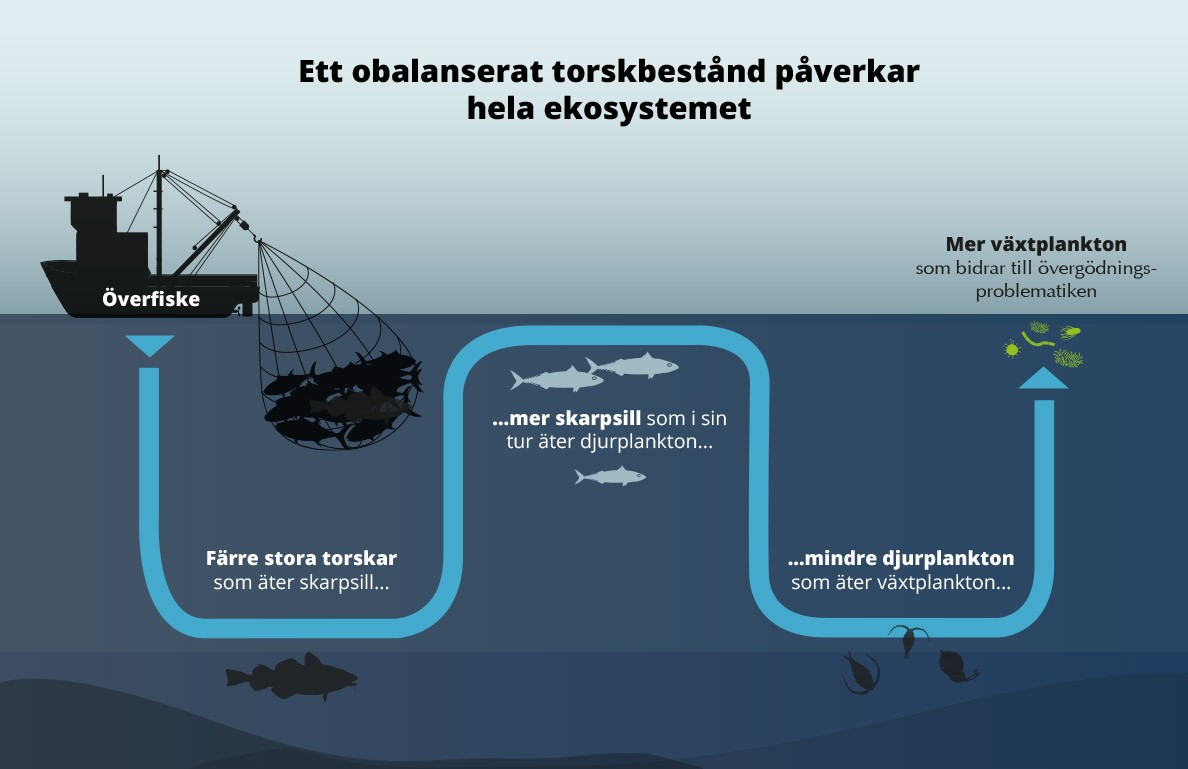Search press releases
Fisheries Brief No. 4: The role of cod in the ecosystem
Research shows that Baltic Sea cod play an essential role in the sea’s ecosystem. As the top predator, cod is of major importance to Baltic Sea plant and animal life. This means that disturbance to the cod stock has consequences throughout the entire sea.
Cod fulfil a range of functions in the ecosystem, depending on age and size. Young cod subsist on small zooplankton – it is only later in life that cod feed on other fish. In this manner, cod of various sizes regulate the population of other species. Cod have become smaller in both length and breadth in recent years. Cod currently spawn at an average size of 20 centimetres, as compared with 40 centimetres just twenty years ago. Excessive fishing pressure is one reason for this dramatic decrease in size. For decades, trawling has been catching all cod larger than 35 centimetres. The result is a Baltic Sea cod stock of small, undersized fish rather than robust fish of various sizes. Today’s cod stock is unable to fulfil its function in the ecosystem, and the balance of the Baltic Sea is threatened.
Text in illustration:
An unbalanced cod stock affects the entire ecosystem
Overfishing
Fewer large cod to feed on sprat
… more sprat, which feed on zooplankton
… less zooplankton, which feed on phytoplankton…
More phytoplankton, which causes eutrophication problems
Due to favourable conditions for reproduction during the 1970s, the Baltic Sea cod stock reached record high levels and cod were commonly found in many areas in the Baltic Sea. The cod stock decreased dramatically in the mid-1980s, and then collapsed completely due to high fishing pressure combined with difficult conditions for reproduction. As the cod stock decreased in size and the number of spawning areas fell from three to one, the cod’s range in the Baltic Sea also decreased. The cod’s disappearance from specific areas allowed researchers to study the effects of the cod’s decline on other species in the ecosystem. In places where the cod had disappeared there was a dramatic increase in the cod’s main food – sprat. The sprat stock’s varying size over time could be correlated with the size of the cod stock. This has a domino-like effect on other species and organisms in the sea. Sprat feed primarily on zooplankton, which was cut back as the sprat stock grew. And the amount of phytoplankton increased as zooplankton decreased – which can intensify the effects of eutrophication.
This demonstrates the interdependency between different marine species. The overfishing of a key species like cod affects not only that particular species, but also the food chain as a whole. The main factors affecting the cod’s range and the stock’s size are the amount of fishing pressure and Baltic Sea salinity and oxygen levels. Humans have direct control over fishing – one of these critical factors.
The cod’s crucial role in the ecosystem illuminates the importance of fisheries management that views the ecosystem as a whole. In 2015 the EU adopted a multi-year plan for management of Baltic Sea cod, sprat and herring. The idea behind the plan is to base management of the cod stock on consideration of how the various species affect each other. No measures have yet been introduced under the multi-year plan to redress the distressed cod stock. In view of the cod’s crucial role in the balance of the Baltic Sea as a whole, it is high time something is done. A ban on bottom trawling should be a first step towards allowing the cod stock to recover.
Click here to read Fisheries Brief No.1, 2 and 3:
Fisheries Brief No. 1: How big is the fishing industry?
Fisheries Brief No. 2: Discards continue despite ban
Fisheries Brief No. 3: The Baltic Sea cod – a unique and isolated species










